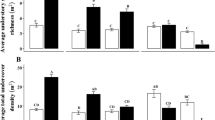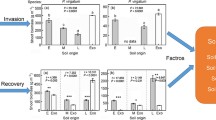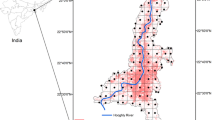Abstract
Many exotic plants utilize early successional traits to invade disturbed sites, but in some cases these same species appear able to prevent re-establishment of late-successional and native species. Between 2002 and 2004, I studied 25 fields that represent a 52-year chronosequence of agricultural abandonment in a shrub-steppe ecosystem in Washington State, USA, to determine if exotic plants behaved as early successional species (i.e., became less abundant over time) or if they established persistent communities. Exotics maintained dominance in tilled (73% of total cover) relative to never-tilled (6% of total cover) fields throughout the chronosequence. Exotic community composition, however, changed on annual and decadal timescales. Changes in exotic community composition did not reflect typical successional patterns. For example, some exotic perennial species (e.g., Centaurea diffusa and Medicago sativa) were less common and some exotic annual species (e.g., Sissymbrium loeselii and S. altissimum) were more common in older relative to younger fields. Exotics in the study area appeared to establish communities that are resistant to re-invasion by natives, resilient to losses of individual exotic species, and as a result, maintain total exotic cover over both the short- and long-term: exotics replaced exotics. Exotics did not invade native communities and natives did not invade exotic communities across the chronosequence. These results suggest that, in disturbed sites, exotic plants establish an alternative community type that while widely variable in composition, maintains total cover over annual and decadal timescales. Identifying alternative state exotic communities and the mechanisms that explain their growth is likely to be essential for native plant restoration.
Similar content being viewed by others
References
Bais HP, Vepachedu R, Gilroy S, Callaway RM, Vivanco JM (2003) Allelopathy and exotic plant invasion: from molecules and genes to species interactions. Science 301:1377–1380
Bonet A, Pausas JG (2004) Species richness and cover along a 60-year chronosequence in old-fields of southeastern Spain. Plant Ecol 174:257–270
Callaway RM, Thelen GC, Rodriguez A, Holben WE (2004) Soil biota and exotic plant invasion. Nature 427:731–733
Callaway RM, Walker LR (1997) Competition and facilitation: a synthetic approach to interactions in plant communities. Ecology 78:1958–1965
Corbin JD, Dȁ9Antonio CM (2004) Competition between native perennial and exotic annual grasses: implications for an historical invasion. Ecology 85:1273–1283
Deȁ9ath G (1999) Extended dissimilarity: a method of robust estimation of ecological distances from high beta diversity data. Plant Ecol 144:191–199
Denslow JS, Hughes RF (2004) Exotic plants as ecosystem dominants. Weed Technol 18:1283–1287
Foster BL, Tilman D (2000) Dynamic and static views of succession: testing the descriptive power of the chronosequence approach. Plant Ecol 146:1–10
Hansen MJ, Clevenger AP (2005) The influence of disturbance and habitat on the presence of non-native plant species along transport corridors. Biol Conserv 125:249–259
Klironomos JN (2002) Feedback with soil biota contributes to plant rarity and invasiveness in communities. Nature 417:67–70
Kyser GB, DiTomaso JM (2002). Instability in a grassland community after the control of yellow starthistle (Centaurea solstitialis) with prescribed burning. Weed Sci 50:648–657
Lenfesty CD (1980). Soil survey of Okanogan County Area, Washington. National Cooperative Soil Survey
Lortie CJ, Brooker RW, Choler P, Kikvidze Z, Michalet R, Pugnaire FI, Callaway RM (2004) Rethinking plant community theory. Oikos 107:433–438
Mack MC, Dȁ9Antonio CM (1998) Impacts of biological invasions on disturbance regimes. Trend Ecol Evol 13:195–198
Mack RN, Simberloff D, Lonsdale WM, Evans H, Clout M, Bazzaz FA (2000) Biotic invasions: causes, epidemiology, global consequences, and control. Ecol Appl 10:689–710
Maron JL, Connors PG (1996) A native nitrogen-fixing shrub facilitates weed invasion. Oecologia 105:302–312
Meiners SJ, Cadenasso ML, Pickett STA (2004) Beyond biodiversity: individualistic controls of invasion in a self-assembled community. Ecol Lett 7:121–126
Meiners SJ, Pickett STA, Cadenasso ML (2001) Effects of plant invasions on the species richness of abandoned agricultural land. Ecography 24:633–644
Middleton B (2002) Nonequilibrium dynamics of sedge meadows grazed by cattle in southern Wisconsin. Plant Ecol 161:89–110
Rejmanek M (1996) A theory of seed plant invasiveness: The first sketch. Biol Conserv 78:171–181
Rejmanek M, Richardson DM (1996) What attributes make some plant species more invasive? Ecology 77:1655–1661
Seabloom EW, Borer ET, Boucher VL, Burton RS, Cottingham KL, Goldwasser L, Gram WK, Kendall BE, Micheli F (2003) Competition, seed limitation, disturbance, and reestablishment of California native annual forbs. Ecol Appl 13:575–592
Sheley RL, Petroff JK (1998) Biology and management of noxious rangeland weeds. Oregon State University Press, Corvallis
Sheley RL, Petroff JK (1999) Biology and management of noxious rangeland weeds. Oregon State University Press, Corvallis
Simberloff D, Von Holle B (2000) Positive interactions of non-indigenous species:invasional meltdown? Biol Invasions 1:21–32
Stylinski CD, Allen EB (1999) Lack of native species recovery following severe exotic disturbance in southern Californian shrublands. J Appl Ecol 36:544–554
R Research Core Team (2004) R: A language and environment for statistical computing. In: R Foundation for Statistical Computing, Vienna, Austria
Tilman D (1985) The resource-ratio hypothesis of plant succession. Am Nat 125:827–852
Vivanco JM, Bais HP, Stermitz FR, Thelen GC, Callaway RM (2004) Biogeographical variation in community response to root allelochemistry: novel weapons and exotic invasion. Ecol Lett 7:285–292
Acknowledgments
This research was funded by USDA-NRI (# 35320-13473), the Utah State Agricultural Experimental Station, and the Switzer Foundation. I thank J. Mountjoy, C. Miller, and C. McCorkel for providing management histories; the Washington Department of Wildlife, the Methow Conservancy, and Rainier Seeds Inc. for help in the field; and K.H. Beard, G.P. Kyle, and J.M. Stark for reviewing earlier versions of this manuscript.
Author information
Authors and Affiliations
Corresponding author
Appendix
Appendix
Rights and permissions
About this article
Cite this article
Kulmatiski, A. Exotic plants establish persistent communities. Plant Ecol 187, 261–275 (2006). https://doi.org/10.1007/s11258-006-9140-5
Received:
Accepted:
Published:
Issue Date:
DOI: https://doi.org/10.1007/s11258-006-9140-5




